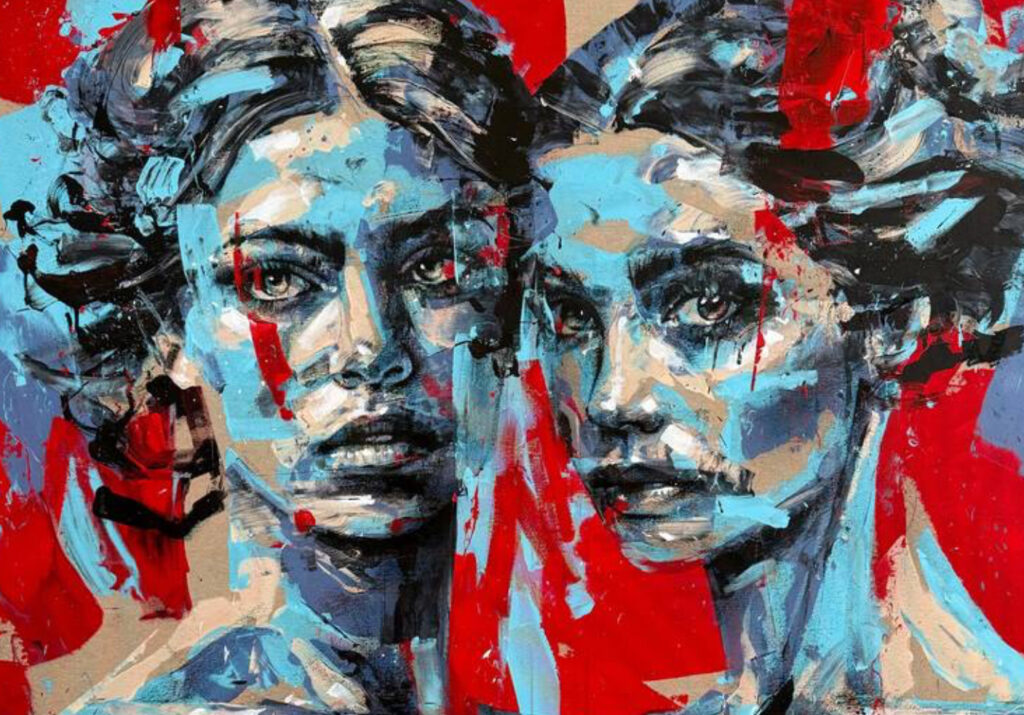In oil and abstraction, a Portuguese painter captures more than dance—he captures the fleeting soul of movement.
Movement is notoriously difficult to trap in a static medium. Most painters don’t even try. They focus on stillness, on moments frozen in time. But Mario Henrique is not most painters. With Bolshoi No. 1, he takes on the near-impossible: turning raw, kinetic energy into oil on canvas.
At first glance, the work is a blur. A ghost of a figure. Or perhaps a blaze. But linger just a moment longer, and you’ll see it—it’s a dancer. Mid-motion, mid-madness, mid-expression. Not a detailed rendering, but a burst. A statement of momentum. Of form born through fury.
This is not a painting of a ballerina; it is ballet itself, distilled into brushstroke.
The Artist: Mario Henrique and the Language of Speed
Mario Henrique is a Portuguese painter who has built a career on portraying the human face and body with expressive immediacy. His approach eschews photographic realism for something far more urgent—emotion, imperfection, motion, decay. His backgrounds are raw. His color palettes, daring. His brushwork feels like an act of demolition and celebration at once.
With Bolshoi No. 1, he applies this approach to the figure of a dancer—presumably one trained in the disciplined style of the famed Bolshoi Ballet. But don’t expect a homage to tradition. What Henrique does here is not simply “paint a dancer.” He challenges the viewer to confront dance in its purest, most disobedient form.
This is not portraiture. It is performance captured mid-breath.
Visual Analysis: Form, Color, and Chaos
The painting stands vertically, emphasizing the rise and fall of the dancer’s movement. The figure is central, but not rigidly so. She emerges from the chaos of Henrique’s brushwork like a specter—part woman, part gesture.
Her body leans into motion. There’s a clear sense of rotation, of limbs arcing through space. The background is thick with energetic strokes—whites, blacks, umbers, and blood reds—that suggest a stage, a crowd, or perhaps the inner workings of her mind as she moves.
The color is not polite. It’s dramatic. Almost violent. The reds do not flatter her cheeks; they slash across the canvas. The blacks don’t outline; they obscure. The whites don’t highlight; they blind.
And yet, somehow, she glows. The dancer, though buried under paint, remains unmistakably human. Not in the classic anatomical sense, but in presence. In soul.
Henrique’s signature use of palette knives and spontaneous application techniques—flinging, scraping, layering—add to the immediacy. There’s no evidence of revision. No careful erasure. What you see is what was felt. A performance not rehearsed, but lived.
Motion as Narrative
What makes Bolshoi No. 1 so compelling isn’t just how it looks, but how it moves. It may be a still image, but it vibrates with velocity. The viewer feels the centrifugal force of the dancer’s turn. Her skirt—if we can even call it that—is a streak of color, giving the illusion of volume. Her hair flies, not because Henrique painted it precisely, but because he allowed his strokes to lose control.
Motion is not depicted—it is unleashed.
This method turns the painting into a kind of time capsule. One second of a larger story. But instead of freezing that second like a photograph, Henrique paints everything that second contains: the tension before the leap, the gravity defied, the sweat, the strain, the risk of falling.
He paints not what the dancer looks like—but what the dance feels like. To her. To us.
Symbolism and Emotional Undertones
There is something quietly tragic about Bolshoi No. 1. Despite its kinetic energy, there’s an undercurrent of exhaustion, even sacrifice. The dancer is beautiful, yes—but she’s also dissolving. Her limbs aren’t crisply defined, but breaking apart. Her face, if it’s there at all, is a smear.
This is no flawless prima ballerina caught in the perfection of form. This is someone giving everything to the performance—even her shape.
In that way, the painting becomes a broader metaphor for any pursuit of excellence. Whether it’s art, sport, or survival, there’s a cost to going full-out. The dancer in Bolshoi No. 1 is both divine and destroyed by her moment.
The title itself invites interpretation. “Bolshoi” refers to the Russian word for “big” or “grand,” and by extension, the Bolshoi Ballet—one of the world’s most iconic institutions of dance. By invoking that name, Henrique acknowledges the weight of tradition, the discipline, the grandeur. But he doesn’t show us the Bolshoi in its usual aesthetic. He strips it raw.
This is not a tribute. It’s a reinterpretation. A rebellion.
Cultural Context: Painting Dance, Painting Women
There is a long history of painters engaging with dance. Degas, of course, immortalized ballerinas in pastels and oils with almost clinical attention to composition. Toulouse-Lautrec depicted dancers in the sweaty, smoky atmosphere of French cabarets. Even Picasso had his take, often abstracted into surrealist dimensions.
What Henrique brings is distinctly 21st-century. His dancer isn’t static or symbolic. She’s not a muse, not a decoration, not a formal study. She is action personified. She is paint in motion.
And in doing so, Henrique also comments on the female form in modern art. He doesn’t render her to be admired for her lines or proportions. He renders her to be felt. Her presence is not about beauty, but intensity. She is not docile. She is electric.
Technique: The Violence of Creation
Mario Henrique’s method is crucial to understanding Bolshoi No. 1. His tools—primarily palette knives and large brushes—don’t lend themselves to gentle detail. Instead, they force boldness. The result is a surface rich in texture and urgency.
He paints fast. Or at least, he paints with an energy that reads as fast. There’s no time for self-doubt on this canvas. The brushstrokes slice across the scene like declarations.
This speed matters. It aligns with the subject. Dance is fleeting. So is inspiration. So is youth. So is everything, really. And Bolshoi No. 1 seems painfully aware of that. The painting doesn’t try to preserve the dancer. It celebrates her while she’s vanishing.
Interpretation: Why It Resonates
Why does this painting work so well? Why does it linger in the viewer’s mind?
Because it taps into something primal. Movement. Expression. Struggle. Bolshoi No. 1 is about the friction between form and chaos. It’s about creating something beautiful in the middle of destruction. It reminds us that the most impactful moments in life are rarely neat. They’re messy. Glorious. Dangerous.
And that’s what Henrique gives us. A moment not polished, but pulsing.
In a world that craves perfection, Bolshoi No. 1 dares to be incomplete. It dares to be alive.
The Lasting Echo of Motion
Mario Henrique’s Bolshoi No. 1 is not just a painting of a dancer. It is a full-bodied performance locked into pigment. It challenges the viewer to see not the shape of the subject, but the soul of her action.
This work isn’t for the passive observer. It demands attention. It refuses to be background. It doesn’t hang quietly on a wall—it bursts off it.
And maybe that’s the ultimate takeaway: that art, like dance, is not always about what you see. It’s about what it makes you feel. What it dares you to remember.
With Bolshoi No. 1, Mario Henrique doesn’t just capture a dancer—he captures what it means to move through this world with purpose, passion, and just a touch of beautiful self-destruction.
No comments yet.








